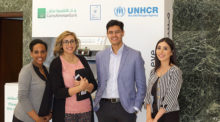Alex Gillis
This spring, a group of students from the University of Toronto stepped into the waiting area of the Cairo Amman Bank, in northern Jordan, to see an inspiring sight. The area contained comfortable chairs facing tellers in a perimeter inside the bank, making it easy for Syrian refugees to use iris-scanning technology to access a cash-assistance program. This is a huge improvement over the problems of past programs in other regions.
“It was like a bank branch in Canada – maybe better – organized to be highly functional,” says Adam Sheikh, a Munk School of Global Affairs undergraduate student, one of five U of T students who travelled to Jordan to research the success of UNHCR Jordan’s Biometric Cash Assistance Program.
“The UNHCR partnered with Cairo Amman Bank and other organizations to launch the world’s first refugee, cash-assistance program that uses iris-scan technology,” Sheikh says. The UNHCR is the United Nations High Commission for Refugees.
The trip was part of the Munk School’s Reach Project, an initiative led by Professor Joseph Wong, the Roz and Ralph Halbert Professor of Innovation at the Munk School. The project focuses on researching cases that demonstrate successful delivery of social services to hard-to-reach populations, and the Jordan program was a good example of that.
Supported through a partnership with the MasterCard Center for Inclusive Growth, the Reach Project began in 2015 with students travelling to Brazil and, in 2016, to South Africa. Four trips are planned this year to India, Thailand, Rwanda and Jordan, where students study best practices that can be used in other settings where poverty alleviation means reaching the hardest to reach.
The Reach Project offers an opportunity for students to conduct high-quality research. Approximately 140 students applied for the current teams, each of which includes four or five grads and undergrads.
Jordan is responding to an influx of Syrian refugees – more than 650,000, approximately 15 times more than Canada has accepted.
Elizabeth Assefa (a recent graduate from the Master of Global Affairs program at the Munk School), Marin MacLeod (a second-year student in the Master of Public Health program at the Dalla Lana School of Public Health), and U of T undergrads Adam Sheikh, Natalie Boychuk and Daniel Park, conducted several interviews with the UNHCR, local NGOs and businesses.
“We spent the past year conducting background research,” says Sheikh, who’s also working on an initiative to address dangerous working conditions in Qatar.
While in Jordan, the team discovered the reasons for the program’s success, including the substantial effort by UNHCR Jordan and partner organizations to register, support and visit hundreds of thousands of refugees in their homes. However, integrating the iris-scan technology into the program was a major factor in the success.
“It makes it easier and more cost-efficient to identify and transfer the cash to those who are most vulnerable,” explains Assefa, who has also worked with refugees in South Africa. Previous cash-assistance programs that relied on debit cards presented problems, such as card loss and fraud. These and other challenges have been overcome, thanks to the iris-scan technology. Now, approximately 95 per cent of cash donations go directly to refugees, an outstanding example of reaching hard-to-reach communities.
“This sort of efficiency is remarkable,” MacLeod adds. “A lot of that has to do with giving refugees more autonomy. Giving cash is more efficient than giving items, because refugee families know better than anyone what they need.”
June 7, 2017
